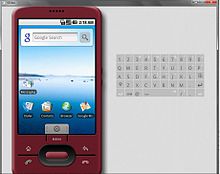Android Development Tools
The Android Development Tools ( ADT for short ) were development tools offered by Google in the form of plug-ins for the Eclipse development environment . They enabled Android software development (development of projects for the Android operating system ).
On June 26, 2015, Google announced that it would discontinue ADT support in favor of the Android Studio integrated development environment at the end of 2015; Android Studio has thus been declared the official development environment and a change is suggested by Google. The discontinuation affects the support of Eclipse, the ADT plugins for Eclipse and the Apache Ant based build system , which was replaced by Gradle . A switch to Android Studio as the development environment and to the Gradle creation process requires a migration of old projects; this is supported by an import function from Android Studio and an accompanying documentation.
The Android Development Tools 23.0.7 are the last officially supported version and were released in August 2015. This version requires Eclipse 3.7.2 ("Indigo") and the Android Software Development Kit (SDK) version 24.1.2. Java 7 is required for the development of Android projects from version 5.0 ("Lollipop") , developments for older versions of the Android platform require Java 1.6.
AndMore is an open source development of Android support for the Eclipse IDE, which is partly based on the Android Development Tools (as of June 2015).
integration
The ADT provide functions of the separately available Android Software Development Kit (SDK) via Eclipse and integrate them into the user interface of the IDE:
- Android SDK Manager to manage and integrate available Android versions as well as dependent and optional libraries ,
- provided by Google and selected device manufacturers,
- Android Virtual Device Manager for configuration and control of virtual Android emulator instances (AVD)
- Functions for building and transferring (deployment) Android applications to devices or emulator instances using the Android Debug Bridge (ADB),
- Installation of a USB driver is necessary for selected devices and operating systems,
- Functions for source code completion, generation of source code and visual processing (layout and XML editors),
- Functions for static code analysis ( Lint for Android),
- Functions for error and performance analysis ( debugger , profiler ),
- Functions for interaction with a connected (virtual) device using DDMS, the Dalvik Debug Monitor Server (logging and display of log outputs, creation of screenshots and videos, memory, GPU and network monitoring = monitoring ),
- rudimentary support for the Native Development Kit (NDK),
- Support for selected Google services .
Android Virtual Device
The Android Virtual Device is an emulator that can be used to simulate almost any Android device. API level, operating system version and inserted memory card size can be specified. There are also other features such as GPS support, number of emulated cameras and speed sensors that can be added and edited. The supplied DDMS allows logging from the breakpoints and events defined in the source code and the display of device data and information about current processes.
Individual evidence
- ↑ Android SDK Plugin for Eclipse - Update Site .
- ↑ An update on Eclipse Android Developer Tools .
- ↑ ADT Plugin (UNSUPPORTED) - Android Studio .
- ↑ Meet Android Studio - Android Studio .
- ↑ SDK Tools Release Notes - Android Studio .
- ↑ Christopher Guindon: Eclipse Andmore . 17th December 2014.

